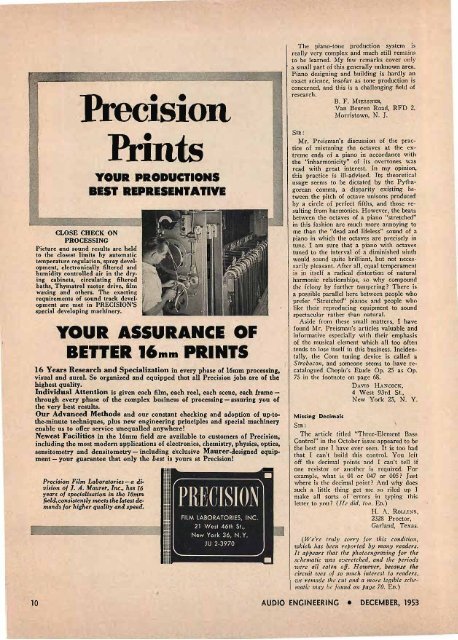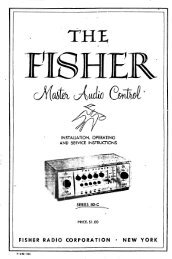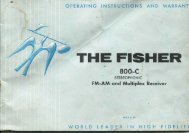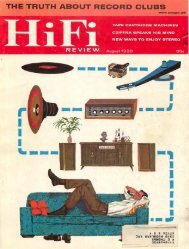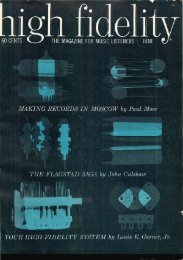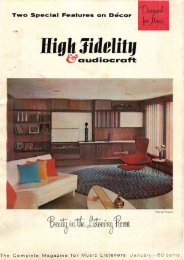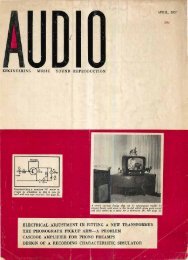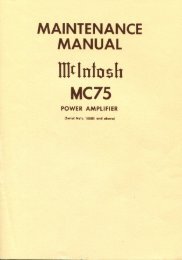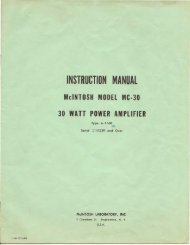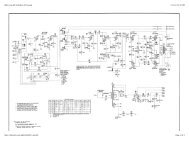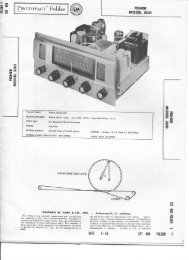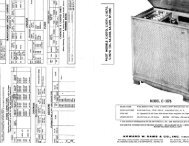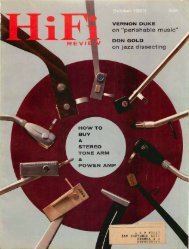anywhere
Audio Enginnering magazine December 1953 - Vintage Vacuum ...
Audio Enginnering magazine December 1953 - Vintage Vacuum ...
- No tags were found...
Create successful ePaper yourself
Turn your PDF publications into a flip-book with our unique Google optimized e-Paper software.
Precision<br />
Prints<br />
YOUR PRODUCTIONS<br />
BESI REPRESENIAIIYE<br />
CLOSE CHECK ON<br />
PROCESSING<br />
Picture ana sound results are held<br />
to the " closest limits by automatic<br />
temperature regulation, spray development,<br />
electronically filtered and<br />
humidity controlled air in the drying<br />
cabinets, circulating filtered<br />
baths, Thymatrol motor drive, film<br />
waxing and others. The exacting<br />
requirements of sound track development<br />
are met in PRECISION'S<br />
sPilcial developing machinery.<br />
YOUR ASSURANCE OF<br />
BETTER 16mm PRINTS<br />
16 Years Research and Specialization in every phase of 16mm processing,<br />
visual and aural. So or~anized and equipped that all Precision jobs are of the<br />
highest quality.<br />
Individual Attention is given each film, each reel, each scene, each framethrough<br />
every phase of the complex business of "processing - assuring you of<br />
the very be"st results.<br />
Our Advanced Methods and our constant checking and adoption of up-to.<br />
the-minute techniques, plus new engineering principles and special machinery<br />
enable us to offer service unequalled <strong>anywhere</strong>!<br />
Newest Facilities in the 16mm field are available to customers of Precision,<br />
including the most modern applications of electronics, chemistry, physics, optics,<br />
sensitometry and densitometry - including exclusive Maurer.designed equip.<br />
ment - your guarantee that only the best is yours at Precision!<br />
Precision Film Laboratories - a di·<br />
vision of J. A. Mauret, Inc., has i6<br />
years of specialization in the 16mm<br />
field, consistently meets the latest demands<br />
for higher quality and speed.<br />
The piano-tone production system is<br />
really very complex and much still remains<br />
to be learned. My few remarks cover only<br />
a small part of this generally unknown area.<br />
Piano designing and building is hardly an<br />
exact science, insofar as tone production is<br />
concerned, and this is a challenging field of<br />
research.<br />
B. F. MIESSNER,<br />
Van Beuren Road, RFD 2,<br />
Morristown, N . J.<br />
SIR:<br />
Mr. Preisman's discussion of the practice<br />
of mistuning the octaves at the extreme<br />
ends of a piano in accordance with<br />
the "inharmonicity" of its overtones was<br />
read with great interest. In my opinion,<br />
tl:is practice is ill-advised. Its theoretical<br />
usage seems to be dictated by the Pythagorean<br />
comma, a disparity existing between<br />
the pitch of octave unisons produced<br />
by a circle of perfect fifths, and those resulting<br />
from harmonics. However, the beats<br />
between the octaves of a piano "stretched"<br />
in this fashion are much more annoying to<br />
me than the "dead and lifeless" sound of a<br />
piano in which the octaves are precisely in<br />
tune. I am sure that a piano with octaves<br />
tuned to the interval 'of a diminished ninth<br />
would sound quite brilliant, but not necessarily<br />
pleasant. After all, equal temperament<br />
is in itself a radical distortion of natural<br />
harmonic relationships, so why compound<br />
the felony by further tampering? There is<br />
a possible parallel here between people who<br />
prefer "Stretched" pianos and people who<br />
like their reproducing equipment to sound<br />
spectacular rather than natural.<br />
Aside from these small matters, I have<br />
found Mr. Preisman's articles valuable and<br />
informative especially with their ' emphasis<br />
of the musical element which all too often<br />
tends to lose itself in this business. Incidentally,<br />
the Conn tuning device is called a<br />
Strobocon, and someone seems ' to have recatalogued<br />
Chopin's Etude Op. 25 as Op.<br />
75 in the footnote on page 68.<br />
Missing Decimals<br />
D AVID<br />
HANCOCK,<br />
4 West 93rd St.,<br />
New York 25, N. Y.<br />
SIR:<br />
The article titled "Three-Element Bass<br />
Control" in the October issue appeared to be<br />
the best one I have ever seen. It is too bad<br />
that I can't build this control. You left<br />
off the decimal points and I can't tell if<br />
one resistor or another is required. for<br />
example, what is 01 or 047 or 005? Just<br />
where is the decimal point? And why does<br />
such a little thing get me so riled up I<br />
make all sorts of errors in typing this<br />
letter to YOll ? (He did, too. ED.)<br />
H. A. ROLLINS,<br />
2328 Proctor,<br />
Garland, Texas.<br />
(We're trltly sorry for this cond·ition,<br />
which has been reported by many readers.<br />
It appears that the photoengraving for the<br />
schematic was overetched, and the periods<br />
were all eaten off. However, becaltse the<br />
circuit 1IJaS of so mu.ch interest to readers,<br />
we remade the Cttt and a m01'e legible schematic<br />
may be found on page 70. ED.)<br />
10 AUDIO ENGINEERING • DECEMBER, 1953


